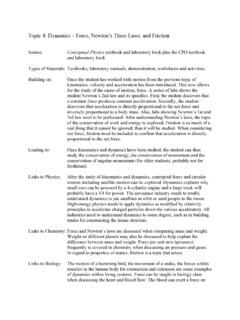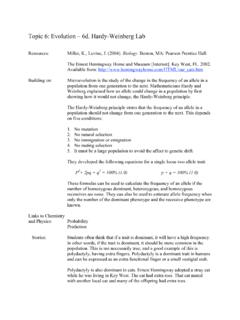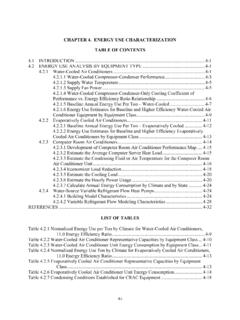Transcription of Topic 5: Work and Energy - Fermilab
1 Topic 5: Work and Energy Source: Conceptual Physics Textbook (Chapter 8), CPO textbook (Chapters 3 and 4), Conceptual Physics lab book (#21, 22, 23, 24, 25, 26, 27, 28) and CPO labs 3A, 3B, 4A, and 4B Types of Materials: Textbooks, laboratory manuals, demonstrations, worksheets and activities Building on: Once vectors, distance, displacement, speed, velocity and net force have been studied, this allows for the study of work (force x displacement) and the study of gravitational potential Energy and kinetic Energy through the use of laboratories. Leading to: When students understand the conservation of work and Energy , seeing connections of all topics from one through four becomes real.
2 Also, the important Topic of Energy plays a very important role in today s world and needs to be explored by students in depth. Links to Physics: Energy is probably the most important Topic studied in physics and other physical sciences. Without understanding it, propelling cars down the road or astronauts to the moon and back would not be possible. Heating and cooling our homes in an efficient manor has become extremely important considering the short supply and cost of fuel. Links to Chemistry: The world of chemistry relies heavily on the understanding of Energy transfer.
3 One example is the extraction of gasoline from crude oil to run motorized vehicles. Another example involves using corn in the fabrication of ethanol or the making of some breakfast cereals. Chemists produce products that are exothermic and endothermic in nature such as heating pads to keep the hands warm in winter of ice packs to place on a sprained knee. Understanding of Energy release by chemicals can result in the formation of companies or just helping out in the kitchen. Links to Biology: People eat food to obtain the Energy it possesses from chemical reactions that allow the person to breathe, walk and run.
4 Plants that grow from the earth extract Energy from the soil s nutrients that come from the sun itself. Materials: (a) Hewitt 1. Lab 21 Making the Grade 2. Lab 22 Muscle Up 3. Lab 23 Cut Short 4. Lab 24 Conserving Your Energy 5. Lab 25 How Hot Are Your Hot Wheels? 6. Lab 26 Wrap Your Energy in a Bow 7. Lab 27 On a Roll 8. Lab 28: Releasing Your Potential (b) Hsu 1. Lab 3A Momentum and the 3rd Law 2. Lab 3B Conservation of Energy 3. Lab 4A Force, Work and Machines 4. Lab 4B Work and Energy (c) My Labs Car Up and Down Ramp (d) Worksheets Work and Energy (e) Demonstrations 1.
5 Bend Wire 2. Lead Shot in Cardboard Tube 3. Pulley and Lever 4. Jumping Disk 5. Energy Transfer #1 6. Energy Transfer #2 (f) Videos and Websites 1. ESPN SportsFigures The Gear Game Video Guide (Mountain Biking) 2. Funderstanding 3-D Coaster Lab Sim (Shockwave) 3. ESPN SportsFigures Perpetual Motion Video Guide (Tony Hawk Skateboarding) 4. The Skater Dude Lab Sim (Java) 5. (This website challenges current thinking in physics in some instances and may be not totally true in others, but I feel it is good (in part) to show parts and have a class discussion. I feel it should generate class interest and perhaps give a spark to that quiet thinker to get hooked on science).
6 A 1 hr. 50-min. video is too long, so showing parts would be appropriate. 6. (The Modern Marvel TV series, Renewable Energy DVD, $ , is a wonderful presentation of the new technology being worked on to supplement oil Energy . Examples include wind, solar, etc., with current knowledge being applied. 7. Shows old footage of inventor of the TV. (g) Good Stories: 1. The Household Match 2. James Joule Topic 5: Energy Lab Work Input and Output Energy Purpose: To compare the work input when a car is pulled up an incline to the output Energy that is put into the car-earth system.)
7 Thus, calculate the energies and efficiencies of the setup. Theory: An inclined plane is one of the six simple machines and input work and output Energy can be easily calculated. The input work can be calculated by multiplying the input force needed to pull the car up the incline times the distance traveled up the incline. The output Energy is equal to the gain in gravitational potential Energy (GPE) if no Energy is lost. So, Input = Output And, with friction, Input = Output + Energy lost by friction.
8 The efficiency of a machine is the comparison of output to input, or efficiency = Output/Input. To make this percent efficiency , just multiply by 100%. F Setup: Added Weight (W) L H Weight causing Cart force up the ramp Procedure: Car = _____N 1.
9 Use a small angle of 15 degrees or so, and pull the cart with a loaded small weight the length of the incline with slotted weights that pull down but go around a movable pulley that changes the direction of the force up the ramp. The amount of slotted weights should be enough to keep the cart going at a constant speed while moving up the ramp (fine-tuning of the weights will be necessary). 2. Record in the following table: The force up the incline (equals the slotted weights in N). The length (L) of the incline in (m). The weight (W) in (N), car and added weights that you are lifting.
10 The vertical height (H) in (m) that the weight was lifted. 3. Repeat procedures 1 and 2 with a heavier weight in the car two more times. Principle of Work Trial Force Up Incline (N) Length of Incline (m) Total Weight Lifted (N) Vertical Height (m) 1 2 3 Use the above data to calculate input work and output Energy and put in the table below. Also do the percent efficiency . Trial Input Work (J) Output Energy (J) efficiency in % 1 2 3 Questions: 1. What happened to the input work values and why, for trials 1, 2 and 3? 2. What happened to the output Energy values and why, for trials 1, 2 and 3?






